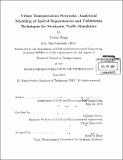| dc.contributor.advisor | Carolina Osorio. | en_US |
| dc.contributor.author | Wang, Carter (Carter Robert Ren-Deh) | en_US |
| dc.contributor.other | Massachusetts Institute of Technology. Department of Civil and Environmental Engineering. | en_US |
| dc.date.accessioned | 2013-12-06T20:50:04Z | |
| dc.date.available | 2013-12-06T20:50:04Z | |
| dc.date.issued | 2013 | en_US |
| dc.identifier.uri | http://hdl.handle.net/1721.1/82859 | |
| dc.description | Thesis (S.M. in Transportation)--Massachusetts Institute of Technology, Department of Civil and Environmental Engineering, 2013. | en_US |
| dc.description | Cataloged from PDF version of thesis. | en_US |
| dc.description | Includes bibliographical references (pages 79-82). | en_US |
| dc.description.abstract | Exact numerical evaluation of the stationary joint queue-length distribution of a Markovian finite capacity network with arbitrary size and topology can be obtained numerically. Nonetheless, the main challenge to such an approach remains the dimensionality of the joint distribution, which is exponential in the number of queues. This thesis proposes an analytical approximation of the joint distribution with a dimension that is linear in the number of queues. The method decomposes the network into overlapping subnetworks. The state of each subnetwork is described aggregately, i.e. in terms of a reduced state space, while ensuring consistency with the disaggregate, i.e., full state space, distribution. This aggregation-disaggregation technique is proposed for the analysis of Markovian tandem finite capacity queueing networks. The model is validated. We present its use to address an urban traffic control problem, and show the added value of accounting for higher-order spatial between-queue dependency information in the control of congested networks. A second, distinct goal of this thesis is to examine the calibration of route choice parameters in microscopic traffic simulators. Automatically calibrating simulators using traffic counts requires describing the relationship between route choice and traffic flows. This thesis proposes an analytical finite capacity queueing model that accounts for the relationship between route choice and traffic flows. The method is embedded in a simulation-based optimization framework and applied to a calibration problem. | en_US |
| dc.description.statementofresponsibility | by Carter Wang. | en_US |
| dc.format.extent | 82 pages | en_US |
| dc.language.iso | eng | en_US |
| dc.publisher | Massachusetts Institute of Technology | en_US |
| dc.rights | M.I.T. theses are protected by
copyright. They may be viewed from this source for any purpose, but
reproduction or distribution in any format is prohibited without written
permission. See provided URL for inquiries about permission. | en_US |
| dc.rights.uri | http://dspace.mit.edu/handle/1721.1/7582 | en_US |
| dc.subject | Civil and Environmental Engineering. | en_US |
| dc.title | Urban transportation networks : analytical modeling of spatial dependencies and calibration techniques for stochastic traffic simulators | en_US |
| dc.title.alternative | Analytical modeling of spatial dependencies and calibration techniques for stochastic traffic simulators | en_US |
| dc.type | Thesis | en_US |
| dc.description.degree | S.M.in Transportation | en_US |
| dc.contributor.department | Massachusetts Institute of Technology. Department of Civil and Environmental Engineering | |
| dc.identifier.oclc | 863435362 | en_US |
